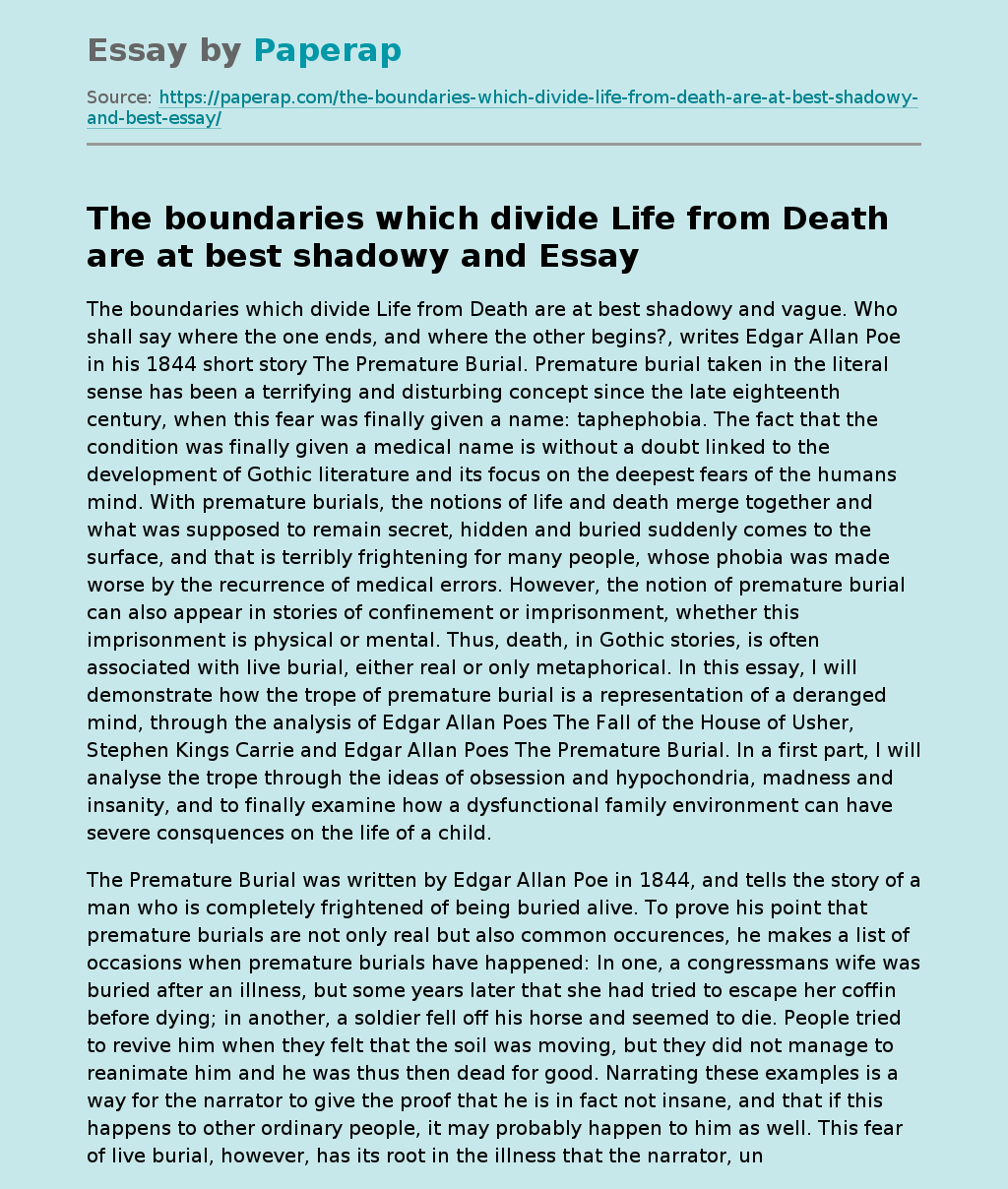The boundaries which divide Life from Death are at best shadowy and
The boundaries which divide Life from Death are at best shadowy and vague. Who shall say where the one ends, and where the other begins?, writes Edgar Allan Poe in his 1844 short story The Premature Burial. Premature burial taken in the literal sense has been a terrifying and disturbing concept since the late eighteenth century, when this fear was finally given a name: taphephobia. The fact that the condition was finally given a medical name is without a doubt linked to the development of Gothic literature and its focus on the deepest fears of the humans mind.
With premature burials, the notions of life and death merge together and what was supposed to remain secret, hidden and buried suddenly comes to the surface, and that is terribly frightening for many people, whose phobia was made worse by the recurrence of medical errors. However, the notion of premature burial can also appear in stories of confinement or imprisonment, whether this imprisonment is physical or mental.
Thus, death, in Gothic stories, is often associated with live burial, either real or only metaphorical. In this essay, I will demonstrate how the trope of premature burial is a representation of a deranged mind, through the analysis of Edgar Allan Poes The Fall of the House of Usher, Stephen Kings Carrie and Edgar Allan Poes The Premature Burial. In a first part, I will analyse the trope through the ideas of obsession and hypochondria, madness and insanity, and to finally examine how a dysfunctional family environment can have severe consquences on the life of a child.
The Premature Burial was written by Edgar Allan Poe in 1844, and tells the story of a man who is completely frightened of being buried alive. To prove his point that premature burials are not only real but also common occurences, he makes a list of occasions when premature burials have happened: In one, a congressmans wife was buried after an illness, but some years later that she had tried to escape her coffin before dying; in another, a soldier fell off his horse and seemed to die. People tried to revive him when they felt that the soil was moving, but they did not manage to reanimate him and he was thus then dead for good. Narrating these examples is a way for the narrator to give the proof that he is in fact not insane, and that if this happens to other ordinary people, it may probably happen to him as well. This fear of live burial, however, has its root in the illness that the narrator, unnamed as in much of Poes stories, suffers from: catalepsy. Catalepsy is a medical condition where the limbs enter a trance-like state and the body suddenly freezes. He thus has the fear that some day this trance will be mistaken for death and he will be buried alive. Actually, at one point in the story, he really believes he has been buried alive and when he finds out that it is actually not the case, his catalepsy disappears and his whole state of mind changes. This story is particularly interesting when discussing the trope of the fear of premature burial, and especially when talking about dangerous, manic and extreme obsessions. The haunting fear that the narrator is an echo to all the deep fear and anxieties that any person can have, except that these fears and anxieties are normally not a matter of life and death, as it is the case with the narrator. Poe exaggerates the concept of phobia because this particular phobia of being buried alive was very widely spread at the time, and what is more, not naming his narrator allows for the message to be impersonal and thus more striking, as it could apply to any one of us. All of his fears and obsession with trying to make sure he is not buried alive consume him first mentally, and then even physically. In doing so the narrator is literally, ironically, burying himself alive. He is completely controlled by his obsession, imprisonned in a jail of his own making, with his fear preventing him from living a normal and sane life. He says no event is so terribly well adapted to inspire the supremeness of bodily and mental distress, as is burial before death (p.313) He is the only one responsible for turning his life into a hell, and it is a good demonstration of how terrifyingly powerful the human mind can be. In The Reader Erect: Edgar Allan Poes The Premature Burial, academic Steven Carter states that in the topsy-turvy world of The Premature Burial, if the living can be mistaken for the dead, it follows unescapably that the dead can be mistaken for the living. Put another way, one may be just as easily (and frequently) buried above the earth as below it. The narrator, because of his unhealthy obsession, is alive without being alive. This story resonates as a warning: we have to be careful not to use imagination too much, because otherwise our thoughts will end up controlling us, instead of us controlling them. Another example of this fear-turned-obession can be found in Ray Bradburys Skeleton, and The Next in Line, published in 1945 in The October Country. In The Skeleton,
The boundaries which divide Life from Death are at best shadowy and. (2019, Dec 06). Retrieved from https://paperap.com/the-boundaries-which-divide-life-from-death-are-at-best-shadowy-and-best-essay/

